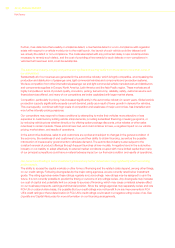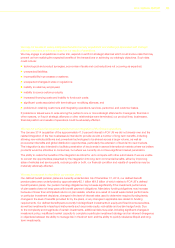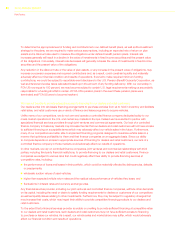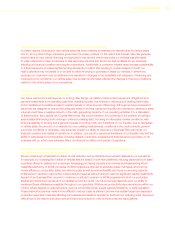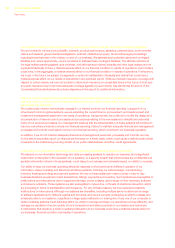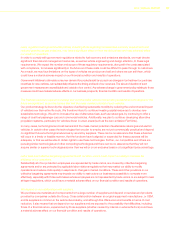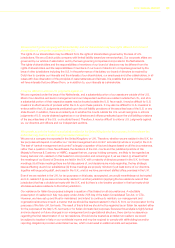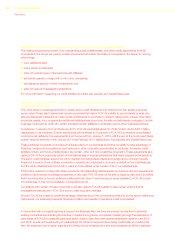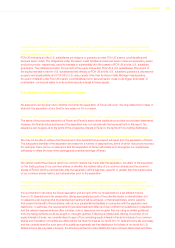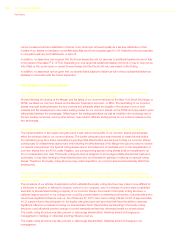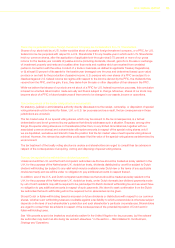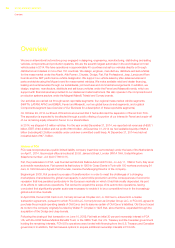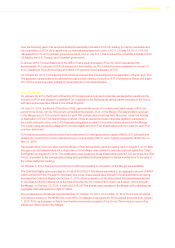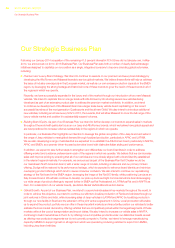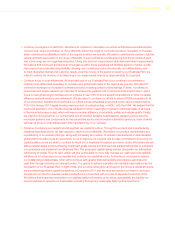Chrysler 2014 Annual Report Download - page 32
Download and view the complete annual report
Please find page 32 of the 2014 Chrysler annual report below. You can navigate through the pages in the report by either clicking on the pages listed below, or by using the keyword search tool below to find specific information within the annual report.
30 2014 | ANNUAL REPORT
Risk Factors
Even if our “central management and control” is in the U.K. as expected, we will be resident in the Netherlands for
Dutch corporate income tax and Dutch dividend withholding tax purposes on the basis that we are incorporated there.
Nonetheless, we will be regarded as solely resident in either the U.K. or the Netherlands under the Netherlands-U.K.
tax treaty if the U.K. and Dutch competent authorities agree that this is the case. We have applied for a ruling from the
U.K. and Dutch competent authorities that we should be treated as resident solely in the U.K. for the purposes of the
treaty. The outcome of that application cannot be guaranteed and it is possible that the U.K. and Dutch competent
authorities may fail to reach an agreement. We anticipate, however, that, so long as the factors listed in the third
preceding paragraph are present at all material times, the possibility that the U.K. and Dutch competent authorities will
rule that we should be treated as solely resident in the Netherlands is remote. If there is a change over time to the facts
upon which a ruling issued by the competent authorities is based, the ruling may be withdrawn or cease to apply.
We therefore expect to continue to be treated as resident in the U.K. and subject to U.K. corporation tax.
Unless and until the U.K. and the Dutch competent authorities rule that we should be treated as solely resident in the
U.K. for the purposes of the Netherlands-U.K. double tax treaty, the Netherlands will be allowed to levy tax on us as a
Dutch-tax-resident taxpayer.
The U.K.’s controlled foreign company taxation rules may reduce net returns to shareholders.
On the assumption that we are resident for tax purposes in the U.K., we will be subject to the U.K. controlled foreign
company, or CFC, rules. The CFC rules can subject U.K.-tax-resident companies (in this case, us) to U.K. tax on the
profits of certain companies not resident for tax purposes in the U.K. in which they have at least a 25 percent direct
or indirect interest. Interests of connected or associated persons may be aggregated with those of the U.K.-tax-
resident company when applying this 25 percent threshold. For a company to be a CFC, it must be treated as directly
or indirectly controlled by persons resident for tax purposes in the U.K. The definition of control is broad (it includes
economic rights) and captures some joint ventures.
Various exemptions are available. One of these is that a CFC must be subject to tax in its territory of residence at
an effective rate not less than 75 percent of the rate to which it would be subject in the U.K., after making specified
adjustments. Another of the exemptions (the “excluded territories exemption”) is that the CFC is resident in a
jurisdiction specified by HMRC in regulations (several jurisdictions in which our group has significant operations,
including Brazil, Italy and the U.S., are so specified). For this exemption to be available, the CFC must not be involved
in an arrangement with a main purpose of avoiding U.K. tax and the CFC’s income falling within certain categories
(often referred to as the CFC’s “bad income”) must not exceed a set limit. In the case of the U.S. and certain other
countries, the “bad income” test need not be met if the CFC does not have a permanent establishment in any other
territory and the CFC or persons with an interest in it are subject to tax in its home jurisdiction on all its income (other
than non-deductible distributions). We expect that our principal operating activities should fall within one or more of the
exemptions from the CFC rules, in particular the excluded territories exemption.
Where the entity exemptions are not available, profits from activities other than finance or insurance will only be subject
to apportionment under the CFC rules where:
some of the CFC’s assets or risks are acquired, managed or controlled to any significant extent in the U.K. (a) other
than by a U.K. permanent establishment of the CFC and (b) other than under arm’s length arrangements;
the CFC could not manage the assets or risks itself; and
the CFC is party to arrangements which increase its profits while reducing tax payable in the U.K. and the
arrangements would not have been made if they were not expected to reduce tax in some jurisdiction.
Profits from finance activities (whether considered trading or non-trading profits for U.K. tax purposes) or from
insurance may be subject to apportionment under the CFC rules if they meet the tests set out above or specific tests
for those activities. A full or 75 percent exemption may also be available for some non-trading finance profits.
Although we do not expect the U.K.’s CFC rules to have a material adverse impact on our financial position, the effect
of the new CFC rules on us is not yet certain. We will continue to monitor developments in this regard and seek to
mitigate any adverse U.K. tax implications which may arise. However, the possibility cannot be excluded that the CFC
rules may have a material adverse impact on our financial position, reducing net returns to our shareholders.


